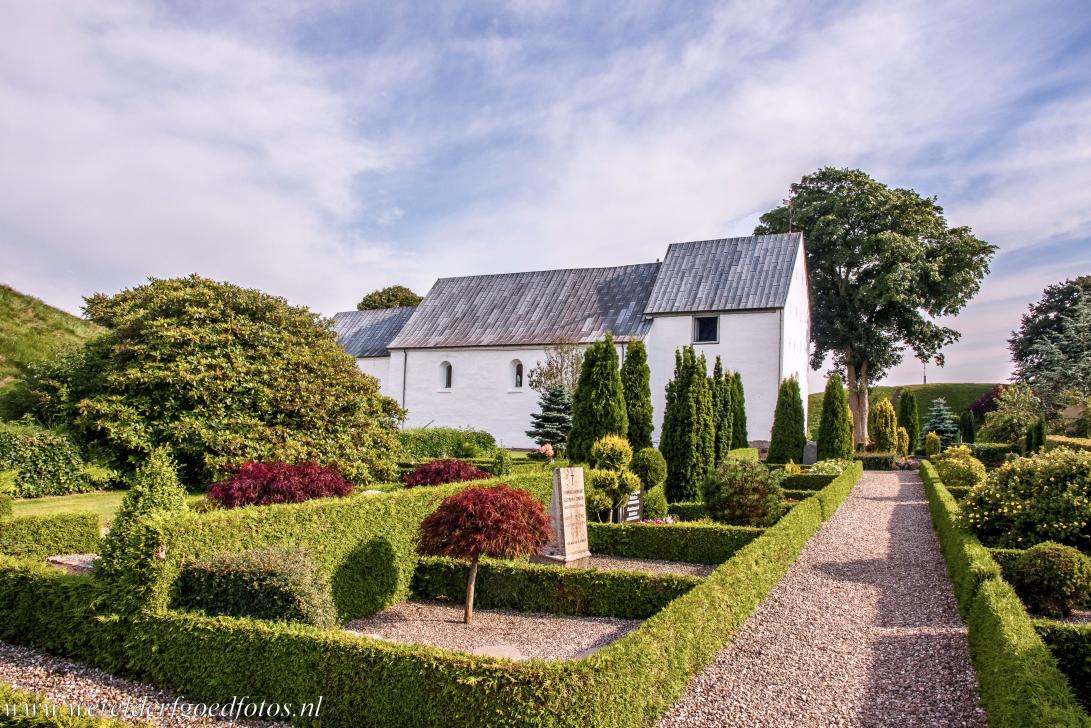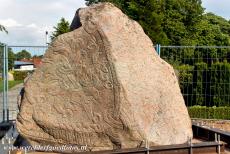Jelling Mounds, Runic Stones and Church: Jelling consists of two burial mounds, the largest known from the Viking Age. In between the burial mounds stands a stone church and two runestones. The Jelling Church was built from travertine around 1100 AD. A grave chamber underneath the 8 metres high north mound was possibly the original grave of King Gorm the Old. The 10 m high south mound was built around 970, the Jelling south mound contained no burials. The smaller and older of the two Jelling Runic Stones was raised by King Gorm the Old. On the runestone of King Gorm, for the first time on Danish ground, the name of Denmark is mentioned. Around 965, the large runestone in Jelling was raised by King Harald Bluetooth in memory of his parents King Gorm the Old and Queen Thyra and also celebrating King Harald's conquest of Denmark and Norway and the conversion of the Danes to Christianity. There are different versions of King Harald Bluetooth's conversion to Christianity, medieval writers such as Widukind of Corvey and Adam of Bremen give conflicting versions about how it happened. The Jelling Mounds are Royale Graves, so the Royal Standard is raised on the Jelling Mounds every summer Sunday. The Kongernes Jelling Museum, opposite the Jelling Church, provides insight into the fascinating history of the Vikings. The village of Jelling is located about 55 km from the World Heritage in Christiansfeld. The Jelling Mounds, Runic Stones and Church were declared a UNESCO World Heritage 1994.
www.werelderfgoedfotos.nl © Copyright World Heritage Photos

Jelling Mounds, Runic Stones and Church: Jelling is a village in Denmark, it is home to the largest known burial mounds dating from the Viking Age. In between the two burial mounds stands the Jelling Church and two runestones, the runestone of King Harald Bluetooth and the runestone of his father King Gorm the Old in memory of his wife Queen Thyra. The Jelling Church was built from travertine stone around 1100 AD. The Jelling Mounds, Runic Stones and Church gained the status as a UNESCO World Heritage in 1994.

Jelling Mounds, Runic Stones and Church: Jelling is a village in Denmark, it is home to the largest known burial mounds dating from the Viking Age. In between the two burial mounds stands the Jelling Church and two runestones, the runestone of King Harald Bluetooth and the runestone of his father King Gorm the Old in memory of his wife Queen Thyra. The Jelling Church was built from travertine stone around 1100 AD. The Jelling Mounds, Runic Stones and Church gained the status as a UNESCO World Heritage in 1994.

Jelling Mounds, Runic Stones and Church: The remains of three wooden churches have been found underneath the present stone Jelling Church. Underneath the floor of the oldest wooden church was the secondary burial of the Danish King Gorm the Old. Originally interred in one of the two Jelling Mounds, King Gorm the Old was apparently reburied in the first wooden church. King Gorm the Old was the Viking king of Denmark. He died in the year 958.

Jelling Mounds, Runic Stones and Church: King Harald Bluetooth (approx. 930-986) had accepted Christianity, he built the first wooden church in Jelling. King Harald Bluetooth erected the church as a mausoleum to his father King Gorm the Old, the Viking ruler of Denmark. This first wooden church and another two wooden churches were distroyed by fire, the present Jelling Church was built of stone in 1100.

Jelling Mounds, Runic Stones and Church: Underneath the eight metres high north mound is a grave chamber built from oak felled around 958-959, it was possibly the original grave of King Gorm the Old, the first historically recognized king of Denmark. He reigned as king of Denmark from approx. 936 until his death in approx. 958. King Gorm the Old ruled from his seat in Jelling. The tomb of King Gorm was discovered under the present Jelling Church in 1978.

Jelling Mounds, Runic Stones and Church: The north burial mound viewed from the Jelling Churchyard. The grave of King Gorm the Old was discovered in 1978 beneath the foundations of the stone Jelling Church, and also a lot of gold threads were found in the grave, which had been woven into a royal costume. For many years, the mortal remains of Gorm the Old were kept for study in the National Museum of Denmark and the University of Copenhagen.

Jelling Mounds, Runic Stones and Church: The colourful frescoes in the chancel of Jelling Church, clearly inspired by Byzantine art, the frescoes depict the birth of Jesus Christ and the worship of the Three Kings. When the original frescoes were discovered in 1875, they were found to have been so badly preserved that they were broken down and in the same year replaced by copies, the original frescoes were created in 1125, they are believed to be the first frescoes in Denmark.

Jelling Mounds, Runic Stones and Church: The simply furnished interior of the Jelling Church, the frescoes are situated behind the altar in the chancel area of the church. In 2000, after extensive studies at the National Museum of Denmark and the University of Copenhagen. In the presence of members of the Danish royal family, the mortal remains of King Gorm the Old were reburied in front of the chancel area in the Jelling Church. The grave of King Gorm the Old is marked by a memorial stone in the church floor.

Jelling Mounds, Runic Stones and Church: Around 965 AD, the larger of the two runestones was erected by the Danish King Harald Bluetooth in memory of his parents King Gorm the Old and Queen Thyra and is also celebrating King Harald Bluetooth's conquest of Denmark and Norway and the conversion of the Danes to Christianity. Therefore, King Harald Bluetooth's runestone at Jelling is called the baptism certificate of Denmark.

Jelling Mounds, Runic Stones and Church: The runestone of King Harald Bluetooth. To prevent further damage from the weather, the Jelling runestones were placed in a glass casinng in 2012. On one side of the runestone of King Harald Bluetooth's, the image of Jesus Christ can be seen, this image of Christ on the runestone is the oldest example in Scandinavia. The inscriptions on the two Jelling runestones are renowned in Denmark.

Jelling Mounds, Runic Stones and Church: The smallest and oldest runestone was raised by the Danish King Gorm the Old in memory of his wife Queen Thyra, called Denmark's Adornment, on the runestone of King Gorm the Old, for the first time on Danish ground, the name of Denmark is mentioned. The larger runestone was erected by King Harald Bluetooth, the son of King Gorm the Old and Queen Thyra, she was considered the first queen of Denmark. The two runestones are among the most important monuments in Danish history.

Jelling Mounds, Runic Stones and Church: The south mound. The Royal Standard of Denmark is raised on the Jelling Mounds every summer Sunday. The ten metres high south mound was built around 970 AD, it contained no burials. Stones found underneath the south mound at Jelling are probably the remains of a stone ship.

Jelling Mounds, Runic Stones and Church: The Royal Standard of Denmark is raised on the Jelling Mounds every summer Sunday because the Jelling Mounds are royale graves. The tiny village of Jelling is situated in central Jutland in Denmark. The Jelling Mounds, the Runic Stones and Jelling Church symbolise the transition of Denmark from Viking paganism to Christianity.

Jelling Mounds, Runic Stones and Church: The present church was built in the Romanesque style in 1100. The Jelling Mounds, the Runic Stones and Jelling Church are among the most significant historic sites in Denmark. The Jelling Mounds, Runic Stones and Jelling Church were inscribed on the UNESCO World Heritage List 1994.

Jelling Mounds, Runic Stones and Church: The Jelling Church seen from the south burial mound. The Kongernes Jelling Museum is situated opposite the Jelling Church, it provides insight into the Jelling monuments and its importance in Danish royal history. A family tree shows the direct line of descent from King Gorm the Old to the present-day Queen Margrethe II of Denmark.
